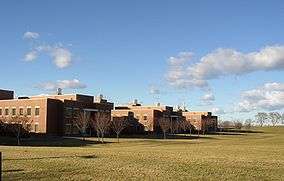Environmental Molecular Sciences Laboratory
 | |
| Established | Oct. 1, 1997 |
|---|---|
Field of research | Biological science, chemical science, environmental science |
| Director | Liyuan Liang |
| Staff |
~150 |
| Users | 10,000+ in 15 years, 700 per year |
| Patents | 84 |
| Instruments | 150 plus |
| Size | About 234,000 square feet |
| Publications | Around 350 per year |
| Address | Located on the Pacific Northwest National Laboratory campus in Richland, Wash. |
| Website |
www |

EMSL (pronounced em-zul), or the William R. Wiley Environmental Molecular Sciences Laboratory, is a national scientific user facility located at Pacific Northwest National Laboratory in Richland, Washington. EMSL is funded by the Department of Energy’s Office of Biological and Environmental Research. EMSL provides experimental and computational resources to address the environmental molecular science challenges facing DOE and the nation.
EMSL offers the global scientific community a range of capabilities and expertise. Access to EMSL’s capabilities is gained through a peer-reviewed proposal process. If a proposal is accepted and the scientist publishes in the open literature, there typically is no charge for using the EMSL instrumentation and capabilities. EMSL provides proposal opportunities throughout the year.[1]
Since it opened in 1997, scientists from all 50 states and more than 35 countries have used EMSL to support their scientific efforts.
Research
Research at EMSL is focused on gaining an understanding of the physics, chemistry and biology governing environmental processes starting at the molecular scale and propagating to larger scales. EMSL’s research focus has been defined into four science themes.[2]
- Atmospheric Aerosol Systems: Developing an understanding of the chemistry, physics and molecular-scale dynamics of aerosols for model parameterization to improve the accuracy of climate model simulations and develop a predictive understanding of climate. By elucidating the role of natural and anthropogenic regional and global climate forcing mechanisms, EMSL can provide DOE and others with the ability to develop cost-effective strategies to monitor, control and mitigate them.
- Biological Dynamics & Design: Focusing on regulation of spatial and temporal parameters of metabolic processes in microbes, fungi, and plants. By gaining a detailed understanding of how biological systems respond to and modify their environment, EMSL can improve strategies for modifying and manipulating plants, fungi and microbes to advance systems biology for bioenergy and biorenewables.
- Energy Materials and Processes: Advancing thedynamic transformation mechanisms and physical and chemical properties at critical interfaces in catalysts and energy materials needed to design new materials and systems for sustainable energy applications. By facilitating the development and rapid dissemination of critical molecular-level information along with predictive modeling of interfaces and their unique properties EMSL helps enable the design and development of practical, efficient, environmentally benign and economic energy storage and energy conversion systems.
- Terrestrial & Subsurface Ecosystems: Building an understanding of the dynamics of nutrients, metabolites, and contaminants at biogeochemical interfaces in heterogeneous environments across multiple scales. By providing a mechanistic understanding of biogeochemical and microbial processes in soils and the subsurface, and linking those processes via pore-scale hydrological models, EMSL can improve strategies for sustainable solutions to contaminant attenuation, remediation and biogeochemical cycling.
Capabilities
EMSL capabilities include:
- Cell Isolation and Systems Analysis – The function of proteins, cells and cell communities can be investigated using super resolution, quantitative fluorescence microscopy with single molecule sensitivity, cell sorting and transcriptomic analysis, together with proteomics, metabolomics and electron microscopy.
- Deposition and Microfabrication – Physical structures ranging in size from miniature objects (nanomaterials) to electrical devices (thin films) with planned properties can be made using deposition and microfabrication. Materials with specific surface, bulk and interfacial properties for energy and environmental applications can be designed and made using this integrated capability.
- Mass Spectrometry – Systems biology and complex mixture studies in biofuels, microbial communities, climate and environmental remediation can be analyzed with world-class separations and mass spectrometry capabilities, providing sensitive compositional and structural information at the molecular level.
- Microscopy – Advancement in energy, environment and biology research relies heavily on micro-, nano- and atomic-scale chemical and structural imaging. Many of EMSL's microscopy instruments have high resolution imaging capabilities including complementary chemical, structural and phase information, in-situ imaging in native environments and imaging dynamic processes with high temporal resolution.
- Molecular Science Computing – Environmental molecular research is accelerated when combined with leading-edge hardware, efficient parallel software, predictive theories and visualization capabilities. Users are encouraged to combine computation with other state-of-the-art experimental tools, providing an integrated platform for scientific discovery. Computing resources include:
- Cascade Supercomputer – Theoretical peak processing speed of 3.4 petaflops. 1440 compute nodes with conventional Xeon processors plus Intel Xeon Phi "MIC" accelerators. 128 GB memory per compute node. 2.7 petabyte shared parallel filesystem (60 gigabytes per second read/write)
- NMR and EPR – Molecular systems important to biology, environmental remediation and sustainability are studied using a suite of nuclear magnetic resonance (NMR) spectrometers with frequencies ranging from 300 to 850 MHz. An ELDOR-capable, 9.5-GHz electron paramagnetic resonance (EPR) spectrometer complements the capability.
- Spectroscopy and Diffraction – Molecular-level solid-, liquid- and gas-interactions can be investigated through structural, chemical and compositional analysis with remarkable atomic-scale spatial and high-energy resolution spectrometers and diffractometers for novel fundamental research.
- Subsurface Flow and Transport – Remediation strategies have been developed for a variety of contaminants by integrating theory, experiment and numerical simulation prior to field-scale studies. Researchers conduct pre-experiment modeling as well as experiments at various scales, and compare experimental and numerical results.
EMSL facilities include a Quiet Wing[3] that opened in early 2012 and a EMSL's RadEMSL (Radiochemistry Annex)[4] that opened to the global user community in the spring 2014.
- Quiet Wing - EMSL’s Quiet Wing was designed to help accelerate science by allowing microscopy equipment to operate at optimal resolution. The wing’s design eliminates or reduces to a minimum the vibrations, acoustics and electromagnetics that can interfere with the resolution of ultra-sensitive scientific instrumentation. The facility and its collection of microscopy and scanning instruments will benefit research areas that include catalysis, fuel cell/energy storage, subsurface science and health-related biology.
- RadEMSL - EMSL’s RadEMSL offers an expansion of capabilities for analysis of radiological samples. It gives users access to a full suite of instrumentation co-located in one facility that is unique in the United States, and one of just a few such facilities worldwide. The RadEMSL instrument suite is optimal for the study of contaminated environmental materials, examination of radionuclide speciation and detection of chemical signatures.
Expertise
EMSL staff and scientific consultants are experts in chemical, physical, biological and computational sciences. They have received numerous awards, been named to society fellowships, have received patents and publish in scientific journals.[5] Since 2009, EMSL staff members have received nearly two dozen awards and honors.[6] In fiscal year 2010, EMSL staff and user research appeared in more than 350 articles, including many in journals, such as Science, Nature, Proceedings of the National Academy of Sciences and Journal of the American Chemical Society.[6]
History
[6][7] The beginnings (1986–1997)
The idea that would become EMSL began in 1985 with a National Academy of Sciences report entitled Opportunities in Chemistry. The report identified scientific challenges relating to energy and the environment that required fundamental research to achieve a solution. Then director of PNNL William R. Wiley and lab senior managers met to discuss the report and how PNNL could respond to the nation’s scientific challenges that were critically dependent on fundamental advances in chemistry. Their recommendations would become EMSL, a center with advanced instrumentation for the study of molecular-level chemistry.
Wiley envisioned a facility where the research was conducted in an integrated and collaborative manner. “Problems don’t come in small, unique, compartmentalized packages. We must recognize the interrelationships,” said Wiley.
Ohio-based Battelle Memorial Institute, which operates PNNL for the U.S. Department of Energy, approved $8.5 million in funding over four years to establish the facility; develop research programs; and obtain the equipment, facilities, scientists and staff to support these programs.
The DOE authorized PNNL to proceed in October 1993, and PNNL began construction of the facility in July 1994. The facility was dedicated on October 16, 1996, in honor of Wiley, who died three months earlier. Construction was completed in August 1997. Then-DOE Secretary Hazel O'Leary delivered the dedication speech and Wiley’s wife, Gus, cut the ribbon. EMSL opened Oct. 1, 1997, for full operation as DOE’s newest national scientific user facility.
The early years (1997–2001) During its first five years, EMSL operations focused on building capabilities, recruiting scientific leadership and attracting users. The scientific focus then expanded to include biology, particularly the study of naturally occurring microbes for environmental cleanup, alternative energy, and carbon dioxide reduction in the atmosphere – critical challenges addressed by DOE.
EMSL’s early user program focused on single investigator studies – particularly those Wiley championed that crossed disciplinary boundaries – and quickly reached more than 1,000 users per year, representing every state and several foreign countries.
A maturing program (2001–2009) In this period there were two grand challenges. These challenges were team-based, multi-investigator research efforts targeted on two key challenges related to DOE missions:
- a biogeochemistry question concerning the fundamental interaction between microbes and minerals, and
- a study addressing the structure and function of proteins in the cell membrane.

EMSL recently refined its scientific focus into four Science Themes:
- Atmospheric Aerosol Systems
- Biosystem Dynamics & Design
- Energy Materials & Processes, and
- Terrestrial & Subsurface Ecosystems.
In January 2007, EMSL celebrated its first permanent expansion: a nearly 4,000-square-foot raised floor within its high-performance computing operations center to accommodate a more powerful supercomputer. In April 2008, EMSL dedicated a new office pod to distinguished user J. Mike White that houses nearly 100 staff and users. At the same time, EMSL management began pursuing plans for a Radiochemistry Annex and a Quiet Wing.
Building for the future (2009 to present)
In 2009, DOE announced a $60 million investment in capabilities for EMSL from the American Recovery and Reinvestment Act, or ARRA. EMSL used the funds to upgrade some existing capabilities, as well as developing and deploying totally new systems and capabilities.
At this same time, EMSL directed capital funds toward construction of the $8 million Quiet Wing to house up to eight microscopy instruments. The Quiet Wing opened in early 2012. Additionally, EMSL moved forward with plans for a radiological chemistry capability with a Radiochemistry Annex, slated to open in 2014.
EMSL directors
- Thom Dunning — led construction activities, 1994–1997
- Teresa Fryberger — interim director, 1997–1998
- Jean Futrell — 1999–2002
- J.W. Rogers, Jr. — 2002–2004
- Allison Campbell — interim 2004–2005, 2005–2015
- Harvey Bolton — interim 2015-2016
- Liyuan Liang — 2016-present
External links
- EMSL (Environmental Molecular Sciences Laboratory)
- EMSL user access
- Pacific Northwest National Laboratory (PNNL)
- Battelle
- U.S. Department of Energy (DOE)
- DOE Office of Biological and Environmental Research (BER)
References
- ↑ User Access
- ↑ Science Themes
- ↑ Quiet Wing
- ↑ RadEMSL
- ↑ About EMSL
- 1 2 3 2011 Science and Operational Review of the Environmental Molecular Science Laboratory
- ↑ capabilities
Coordinates: 46°20′55″N 119°16′42″W / 46.34861°N 119.27833°W